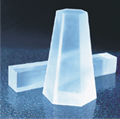|
|
|
|
|
|
|
|
|
|
|
|
|
|
Alkali - Halide Scintillators
 NaI(Tl)
NaI(Tl)
The necessity to use NaI(Tl) crystals in sealed units is counterbalanced by the
fact that they have the greatest light output among all the scintillators and a
convenient emission range coinciding with a maximum efficiency of
photomultipliers with bialkali photocatodes. Moreover, large-size NaI(Tl)
crystals can be produced at a low cost.
CsI(Na)
CsI(Na) is a good alternative for NaI(Tl) in many standard applications because
it has a high light output (85% of that of NaI(Tl)), the emission in a blue
spectral region coinciding with the maximum sensitivity of the most popular PMT
with bialkali photocatodes, and hygroscopicity substantially lower than that of
NaI(Tl).
CsI(Tl)
Since the maximum of emission spectrum is at 550 nm, photodiodes can be used to
detect the emission. Because a scintillator-photodiode pair can be used, it is
possible to reduce significantly the size of the detection system, to do without
a high-voltage power supply, and to use the detection system in magnetic
fields.
CsI(CO3)
We offer a new scintillation material, CsI(CO3). The light output in
gamma-excitation is 60% that of NaI(Tl). The decay time varies from 1.4 to 3.4
ms depending on the dopant concentration. These characteristics allow
CsI(CO3) to be used in combination with other scintillators in
phoswich detectors. CsI(CO3) has an afterglow of 0.05% after 5 microSec.
Undoped CsI
The decay time is ~10 ns. Undoped CsI can be effectively used for experiments in
medium- and high-energy physics.
LiF(W)
The absorption of thermal neutrons in Li-based crystals proceeds according to
the following reaction:
6Li + n - > 4He + 3H + Q
Therefore, the thermal neutrons can be detected against the natural background using the
amplitude discrimination. The lithium nuclei number per unit volume for LiF(W) is greater than that in LiI(Eu)
by a factor of 3.3.
 .Back to top .Back to top
Selector Guide for Alkali Halide Scintillators | Material | Important properties | Applications comments | | | |
| | | | NaI(Tl) | Very high light output, good energy resolution | General scintillation counting, monitoring, health physics, environmental high temperature use |
| | | | CsI(Tl) | Non-hygroscopic, rugged, long wavelength emission | Particle - & high energy physics, general detection, photodiode readout, phoswiches |
| | | | CsI(Na) | High light output, rugged | Geophysical |
| | | | CsI(pure) | Fast, non-hygroscopic, radiation hard | High energy physics (calorimetry) |
| | | | CsI(CO3) | Medium decay time, low afterglow | Gamma-detection, phoswiches |
| | | | LiF(W) | High neutron cross-section | Thermal neutron detection |
| | | | LiI(Eu) | High neutron cross-section, high light output | Thermal neutron detection and spectroscopy |
 .Back to top .Back to top
Physical Properties of Alkali Halide Scintillators | ........... | NaI(Tl) | CsI(Na) | CsI(Tl) | CsI(undoped) | CsI(CO3) | LiF(W) | 6LiI(Eu) | | | | | | | | |
| | | | | | | | | Density [g/cm3] | 3.67 | 4.51 | 4.51 | 4.51 | 4.51 | 2.64 | 4.08 |
| | | | | | | | | Melting point [K] | 924 | 894 | 894 | 894 | 894 | 1133 | 719 |
| | | | | | | | | Thermal expansion coefficient [K-1] | 47.4x106 | 49x106 | 49x106 | 49x106 | 49x106 | 37x106 | 40x106 |
| | | | | | | | | Cleavage plane | <100> | none | none | none | none | <100> | <100> |
| | | | | | | | | Hygroscopic | yes | yes | slightly | slightly | yes | no | very |
| | | | | | | | | Wavelength of emission maximum [nm] | 415 | 420 | 550 | 310 | 405 | 430 | 470 |
| | | | | | | | | Refractive index at emission maximum | 1.85 | 1.84 | 1.79 | 1.95 | 1.84 | 1.4 | 1.96 |
| | | | | | | | | Light output [% of NaI(Tl)](for gamma rays) | 100 | 85 | 45 | 5-6 | 60 | 3.5 | 30-35 |
| | | | | | | | | Primary decay time [microSec] | 0.23 | 0.63 | 1 | 0.01 | 2 | 40 | 1.4 |
| | | | | | | | | Afterglow (after 6 microSec) [%] | 0.3-5 | 0.5-5 | 0.1 | - | 0.06 | - | - |
| | | | | | | | | Lower wavelength cutoff [nm] | 300 | 300 | 320 | 260 | 300 | - | 425 |
 .Back to top .Back to top
|
|
|
|
|
|
|
| Copyright © 2004-2014 by ScintiTech. All rights reserved. |
|
|
|